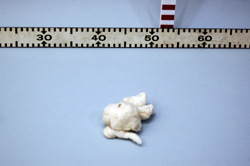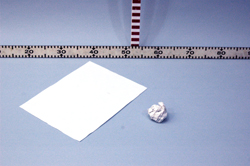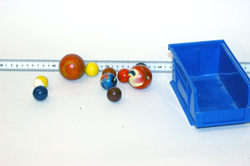Ball, Paper, Cotton Ball Drop, 1C20.16
Topic and Concept:
Motion in One Dimension, 1C20. Uniform Acceleration
Location:
Cabinet: Mechanic (ME)
Bay: (A2)
Shelf: #2&3

Abstract:
A rubber ball, a cotton ball, a sheet of paper, and a crumpled sheet of paper are simultaneously dropped from the same height. Due to the different geometric profiles of each dropped object, the drag force on each will be different.
Equipment |
Location |
ID Number |
|
|
|
Rubber Ball |
ME, Bay A2, Shelf #3 |
|
Cotton Ball |
ME, Bay A2, Shelf #2 |
|
Sheet of Paper |
Provide your own or grab a sheet from the printer |
|
Important Setup Notes:
- N/A
Setup and Procedure:
- From the same height, drop the rubber ball, the cotton ball, the sheet of paper, and the crumpled sheet of paper simultaneously if possible.
- Observe that each object falls at a different rate due to the geometric dependence of air air resistance.
Cautions, Warnings, or Safety Concerns:
- N/A
Discussion:
Air resistance is a particular form of drag which occurs when an object moves through a fluid. The drag force is governed by the drag equation: Fdrag = (1/2)*ρ*v2*CD*A where ρ is the mass density of the fluid (about 1.3 kg/m3 for air at STP), v is the speed of the object relative to the fluid, CD is the drag coefficient which takes into account the specifics of the material and geometry of the object, and A is the reference area which takes into account the orientation of the object as it moves through the fluid (see reference below for clarification). The rubber ball falls most quickly while the sheet of paper falls most slowly. To remove the material dependence of this demonstration, comparison of the fall rates of the sheet of paper vs. its crumpled form works well. The crumpled form falls much more quickly than does the sheet of paper which aptly demonstrates the dependance of drag upon reference area and overall geometry.
|
|
|
Videos:
References:


